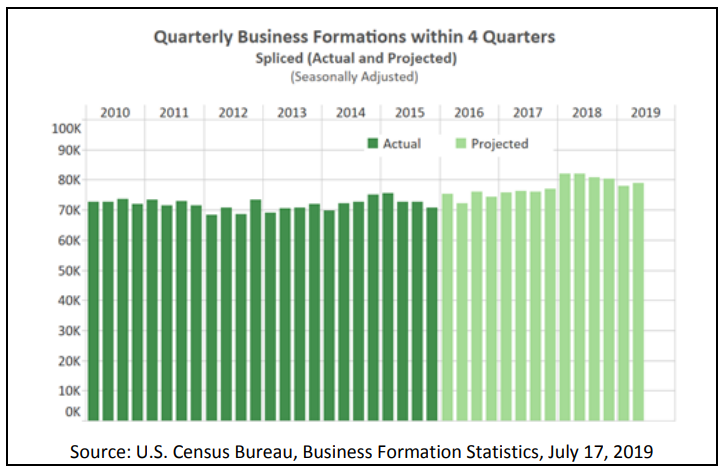With the Census Bureau’s July 17 release of the 2019 2nd Quarter update, the bureau’s Business Formation Statistics (BFS) changed format. Originally developed as an experimental research project in the bureau’s Center for Economic Studies in February 2018, the BFS has been redesigned as a formal release, complete with interactive data selection and visualization tools, and relocated with the bureau’s other regularly released economic indicators.
With this new product, the bureau aims to help businesses, policymakers, regional planners, and researchers assess the current condition of early entrepreneurship at the national and state levels. By providing high-frequency data, the bureau expects that the BFS will enable the study of the dynamics of entrepreneurial activity, the effects of business cycles on entrepreneurship, the effects of regional economic development policies on new business formation, the formation of new industrial clusters, and other topics.
The BFS report provides high frequency data on business applications and employer business formations. Business initiation data are drawn from applications for new Employer Identification Numbers (EIN) and employer business formation data are gathered from the bureau’s Business Register and Longitudinal Business Database. As shown in the diagram below, business applications are segmented into four overlapping categories: 1) total business applications (BA), 2) high-propensity business applications (HBA), 3) business applications with planned wages (WBA), and 4) business applications from corporations (CBA). By mapping businesses’ first instances of payroll tax liabilities to their EIN applications, BFS can provide quarterly data on new business formations by state, region, and across the nation.

Several key variations differentiate the BFS from the existing Business Dynamic Statistics (BDS), which also measure new employer businesses. First, BDS provides data at an annual frequency whereas BFS reports quarterly. Second, BDS uses point-in-time employment data captured from the payroll week covered by March 12 of each year, whereas BFS uses the first instances of payroll tax liability to determine new business formations. Finally, BFS is forward looking and provides projections for how many entities filing for a new EIN in a given quarter are likely to form new businesses within the next four or eight quarters.
Although the frequency and granularity of these data may provide a more realistic picture of new business formation timelines as shown in the image below, there are two primary deficits of the BFS. First is the lag in the availability of administrative payroll data, currently only available up to the 4th quarter of 2016. Another potential problem stems from the fact that the BFS projections are based on an experimental econometric model rather than hard data. Developed in collaboration with economists associated with the Federal Reserve System Board of Governors, Federal Reserve Bank of Atlanta, the University of Maryland, and the University of Notre Dame, the model is vulnerable to non-sampling errors as well as left- and right-censorship. The bureau encourages BFS users to email their feedback on the experimental model to EID.BFS@census.gov.
